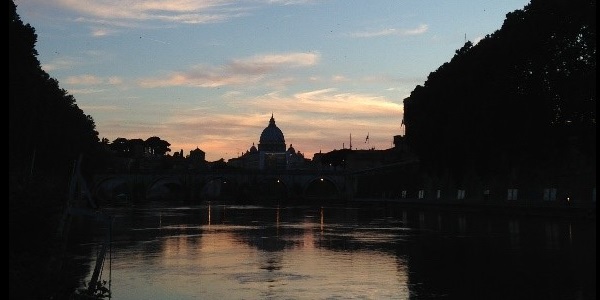October 31, 2016, by Will Leveritt
My experiences of the British School at Rome’s Summer School
Text by Ben White
5th– 17th September 2016: 17 students converge at the heart of the Roman Empire for a 12-day intensive course structured around visits to ancient sites, appreciating the Roman world in the modern-day city.
In a current module of mine, ‘Becoming Roman in the West’, I was recently asked to give a presentation on the origins of urbanisation in late Iron Age Europe. However, instead of first directing my attention to the so-called phenomenon that are the Celtic oppida, I found myself vividly remembering a moment in September.
I was standing with 17 fellow students, in glorious Mediterranean sunshine balanced by the cooling breeze coming from the Tiber bank. We stood in the Forum Boarium, between the iconic Temples of Portunus and Hercules, as Edward Bispham introduced the first day of the 12-day intensive course to us by shedding light on the early origins of Rome in his usual engaging, light-hearted and informative style. Our thematic focus for that day was the Tiber; we learnt how the river provided connections to the fertile and open hinterland, the precious commodities of salt and terracotta, and importantly, interaction with the big wide world of Greeks and Phoenicians; it galvanised the development of the early, archaic settlement.
Following this enlightening experience, we wandered through time, stopping at the crypt of Santa Maria, the area sacra di S.Omobono, the Porticus Aemilia and finally reaching that symbol of a developed mass consumer society, a literal mountain of used amphorae, Monte Testaccio. We stood on top of the hill, exposed to our first panoramic view of the city as Robert Coates-Stephens rounded off the day by highlighting key monuments and sites that would be the focus of the coming days excursions. This exercise expertly demonstrated some of the ways their archaic settlement developed from humble beginnings into a capital of their world.
This memory is one of many: from strolling through the Roman forum, to traversing the steep and narrow roads of Tivoli, finding my feet on the uneven stone roads of Ostia, gazing in awe at the sheer majesty of the remains of Nero’s golden house or Caracalla’s colossal bath complex, standing on the huge steps of Augustus’ temple to Mars Ultor, crouching down to listen as Ed and Rob read out the inscriptions on the Fasti Romani, attempting to recreate the 8-minute walk (run!) from Pantheon door to the original position of the Ara Pacis or trying to appreciate the mindset of the Catilinarian conspirators or Vercingetorix held up in the damp and claustrophobic Tullianum, et cetera, et cetera.
The course adopts a thematic approach, each day having its own theme which is supported by a preceding evening lecture. The days’ itineraries integrate the monuments with museum collections and tours of the latest excavations. Rome was not built in a day, excusing the cliché expression; to appreciate fully the wonders of the ancient city one would need far more than a fortnight. Therefore, the course is tailored to introduce the city in as much depth as possible in two weeks and not to mention the preservation of the aching feet of its participants and convenors!
In all honesty, before participating I felt I possessed a solid grasp of the architectural topography, history and culture of the city. However, the course itself, the BSR staff and fellow students illuminated to me concepts and ideas I had never before thought of. Going into my third year of study, the course has provided me with an extremely wider ground in which to base my studies this year and reminded me of the reasons why I chose to study the ancient world.
Apart from the academic value of the course, there was a thoroughly enjoyable social aspect. Sharing a room with a fellow student, on a corridor with rooms housing the other students and also academics staying at the BSR has its benefits. We would all dine together, in an Italian 3 course style, conversing with one another about the day’s itinerary or more generally about the ancient world – of course, the wine was free-flowing. The course included several free days where we could either stay and utilise the BSR’s extensive library collection, play some football, sit out on the roof, but most importantly, we had the city of Rome at our doorstep!
One of the primary aims of the course, as stressed in the opening lecture, is to show how the famous past of Rome figures in the present and it certainly fulfilled this agenda. Rome is as much an experience as it is a museum. I urge anyone, go, imagine yourselves walking in their footsteps, imagine yourselves making the afternoon stroll down from the Republican Palatine houses to the forum, picture the gruesome fates of those condemned to death in the Colosseum, sit on the Circus Maximus and contemplate the grandeur of the overshadowing imperial palace, take shelter from the rain in a modern adaption of the ancient porticus, appreciate the strain of walking the triumphal route in full military dress let alone in a t-shirt and flip-flops! Experiences are essential in appreciating the lives of the people we dedicate so much of our time to studying and the very fact that we can almost recreate those experiences today is a testament to their glory. Applications will open soon. Go, enrich your studies with these memories and the wisdom of Rob and Ed, you will not regret it!
A big thank you to all involved with the organisation and execution of the course. I would love to return in postgraduate study.
Click here for the BSR Summer School Page.
Click here for a list of the vast number of sites visited and sample itinerary.
No comments yet, fill out a comment to be the first




Leave a Reply